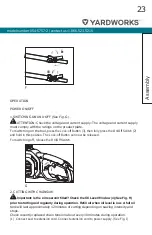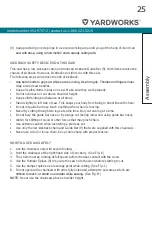
model number 054-5757-2 | contact us: 1.866.523.5218
10
c) Hold the pole pruner by insulated
gripping surfaces only, because the saw
chain may contact hidden wiring or its
own cord. A saw chain contacting a “live”
wire may make exposed metal parts of
the pole pruner “live” and could give the
operator an electric shock.
d) Keep cable away from cutting area.
During operation the cable may be hidden
in shrubs and can be accidentally cut by
the saw chain.
e) Do not use the pole pruner in bad
weather conditions, especially when
there is a risk of lightning. This decreases
the risk of being struck by lightning.
f) To reduce the risk of electrocution, never
use near any electrical power lines.
Contact with or use near power lines may
DBVTFTFSJPVTJOKVSZPSFMFDUSJDTIPDL
resulting in death.
g) Always use two hands when operating
the pole pruner. Hold the pole pruner with
both hands to avoid loss of control.
h) Always use head protection when
operating the pole pruner overhead.
Falling debris can result in serious
QFSTPOBMJOKVSZ
SAVE THESE INSTRUCTIONS
Instructions concerning the proper
techniques for basic felling, limbing, and
cross-cutting
.
1. Felling a tree
When bucking and felling operations are
being performed by two or more persons at
the same time, the felling operations should
be separated from the bucking operation by
a distance of at least twice the height of the
tree being felled. Trees should not be felled
in a manner that would endanger any person,
strike any utility line or cause any property
damage. If the tree does make contact
with any utility line, the company should be
OPUJªFEJNNFEJBUFMZ
The chainsaw operator should keep on the
uphill side of the terrain as the tree is likely to
roll or slide downhill after it is felled.
An escape path should be planned and
cleared as necessary before cuts are started.
The escape path should extend back and
diagonally to the rear of the expected line of
fall as illustrated in Figure 2.
Before felling is started, consider the natural
lean of the tree, the location of larger
CSBODIFTBOEUIFXJOEEJSFDUJPOUPKVEHF
which way the tree will fall.
Remove dirt, stones, loose bark, nails,
staples and wire from the tree.
2. Notching undercut
Make the notch 1/3 the diameter of the
tree, perpendicular to the direction of fall
as illustrated in Figure 2. Make the lower
IPSJ[POUBMOPUDIJOHDVU 8ªSTU5IJTXJMMIFMQ
to avoid pinching either the saw chain or the
guide bar when the second notch (X) is being
made.
3. Felling back cut
Make the felling back cut (Y) at least 2” (5
cm) higher than the horizontal notching cut as
illustrated in Figure 2. Keep the felling back
cut parallel to the horizontal notching cut.
Make the felling back cut so enough wood is
left to act as a hinge. The hinge wood keeps
the tree from twisting and falling in the wrong
direction. Do not cut through the hinge.
As the felling gets close to the hinge, the tree
should begin to fall. If there is any chance
that the tree may not fall in desired direction
or it may rock back and bind the saw chain,
General Safety Rules











































